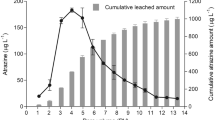Abstract
The analysis of the bacterial community within the soil using DGGE showed acrylonitrile (ACN) could lead to the selection of significantly similar communities. Moreover,Rhodococcus sp. AJ270 was successfully established in the soil community. High GC G+-bacteria also responded positively to ACN addition. Bioaugmentation or carbon addition had no impact on the rate or degree of ACN degradation. ACN could be readily degraded by the soil bacteria, however, the community structure was significantly affected by its addition as well as by the addition of carbon orRhodococcus sp. AJ270. The bioaugmentation of the soil with this strain was successful, in that the organism became established within the community. ACN addition to a soil produces statistically significant changes in the bacterial community.
Similar content being viewed by others
Abbreviations
- ACN:
-
acrylonitrile
- CFU:
-
colony-forming unit(s)
- DGGE:
-
denaturing gradient gel electrophoresis
- PBS:
-
phosphate-buffered saline
References
Alfani F., Cantarella M., Spera A., Viparelli P.: Operational stability ofBrevibacterium imperialis CBS 489-74 nitrile hydratase.J.Mol.Cat.B: Enz. 11, 687–697 (2001).
Altschul S.E., Madden T.L., Schaffer A.A., Zhang J.H., Zhang Z., Miller W., Lipman D.L.: Gapped BLAST and PSL-BLAST a new generation of protein database search programs.Nucl.Acids Res. 25, 3389–3402 (1997).
Aulenta F., Bianchi A., Majone M., Papini M.P., Potalivo M., Tandoi V.: Assessment of natural or enhancedin situ bioremediation at a chlorinated solvent-contaminated aquifer in Italy: a microcosm study.Environ.Internat. 31, 185–190 (2003).
Baxter J., Cummings S.P.: The impact of bioaugmentation on metal cyanide degradation and soil bacteria community structure.Biodegraation, in press (2006).
Blakey A.J., Colby J., Williams E., O’Reilly C.: Regio- and stereo-specific nitrile hydrolysis by the nitrile hydratase fromRhodococcus AJ270.FEMS Microbiol.Lett. 129, 57–62 (1995).
Brandao P.F.B., Clapp J.P., Bull A.T.: Discrimination and taxonomy of geographically diverse strains of nitrile-metabolizing actinomycetes using chemometric and molecular sequencing techniques.Environ.Microbiol. 4, 262–276 (2002).
Cunningham C.J., Ivshina I.B., Lozinsky V.I., Kuyukina M.S., Philip J.C.: Bioremediation of diesel-contaminated soil by microorganisms immobilized in polyvinyl alcohol.Internat.Biodeter.Biodegr. 54, 167–174 (2004).
Deshkar A., Dhamorikar N., Godbole S., Krishnamurthi K., Saravanadevi S., Vijay R., Kaul S., Chakrabarti T.: Bioremediation of soil contaminated with organic compounds with special reference to acrylonitrile.Annal.Chim. 93, 729–737 (2003).
Dhillon J.K., Shivaraman N.: Biodegradation of cyanide compounds by aPseudomonas species (S1).Can.J.Microbiol. 45, 201–208 (1999).
Donberg P.A., Odelson D.A., Klecka G.M., Markham D.A.: Biodegradation of acrylonitrile in soil.Environ.Toxicol.Chem. 11, 1583–1594 (1992).
Drobnica L’., Majtán V., Šturdík E., Miko M.: Effect of 2,3-dinitrilo-1,4-dithia-9,10-anthraquinone onMycobacterium smegmatis.Folia Microbiol. 25, 403–411 (1980).
Hartman S., Smits J.P., Van de Werf M.J., Volkering F., de Bont J.A.M.: Metabolism of styrene oxide and 2-phenylethanol in the styrene-degradingXanthobacter strain 124X.Appl.Environ.Microbiol. 55, 2850–2855 (1989).
Hazardous Substances Data Base (HSDB): U.S. National Library of Medicine: http://toxnet.nlm.nih.gov (2000).
Hu H.Y., Fujie K., Nozawa M., Makabe T., Urano K.: Effects of biodegradable substrates and microbial concentration on the acclimation of microbes to acrylonitrile in aerobic submerged biofilter.Water Sci.Technol. 38, 81–89 (1998).
Komeda H., Kobayashi M., Shimizu S.: A novel gene cluster including theRhodococcus rhodochrous JlnhlBA genes encoding a low molecular mass nitrile hydratase (1-NHase) induced by its reaction product.J.Biol.Chem. 271, 15796–15802 (1996).
McBride K.E., Kenny J.W., Stalker D.M.: Metabolism of the herbicide bromoxynil byKlebsiella pneumoniae subsp.ozaenae.Appl.Environ.Microbiol. 52, 325–330 (1986).
Miller J.M., Gray D.O.: The utilization of nitriles and amides by aRhodococcus species.J.Gen.Microbiol. 128, 1803–1809 (1982).
Munn S.J., Allanou R., Aschberger K., Berthault F., de Bruijn J., Luotamo M., Musset C., O’Connor S., Pakalin S., Paya-Perez A., Pellegrini G., Scheer S., Vegro S.:European Union Risk Assessment Report, Vol. 32. EUR 20857 EN (2004).
Muyzer G., Dewaal E.C., Uitterlinden A.G.: Profiling of complex microbial populations by denaturing gradient gel electrophoresis analysis of polymerase chain reaction amplified genes coding for 16S ribosomal RNA.Appl.Environ.Microbiol. 59, 695–700 (1993).
Neužil J., Krištůfek V., Blumauerová M.: Enzymic degradation of bromoxynil by cell-free extracts ofStreptomyces felleus.Folia Microbiol. 33, 349–354 (1988).
Olano C., Moss S.J., Brana A.F., Sheridan R.M., Math V., Weston A.J., Mendez C., Leadlay P.F., Wilkinson B., Salas J.A.: Biosynthesis of the angiogenesis inhibitor borrelidin byStreptomyces parvulus Tu4055: insights into nitrile formation.Mol.Microbiol. 52, 1745–1756 (2004).
O’Reilly C., Turner P.D.: The nitrilase family of CN hydrolyzing a enzymes — a comparative study.J.Appl.Microbiol. 95, 1161–1174 (2003).
Reyes G.F., Corbett D., Benz F.W., Doyle R.J.: Aerylonitrile induces autolysisBacillus subtilis.FEMS Microbiol.Lett. 182, 255–258 (2000).
Roach P.C.J., Ramsden D.K., Hughes J., Williams P.: Biocatalytic scrubbing of gaseous acrylonitrile usingRhodococcus rubber immobilized on synthetic silicone polymer (ImmobaSil™) rings.Biotechnol.Bioeng. 85, 450–455 (2004).
Rowan A.K., Snape J.R., Fearnside D., Barer M.R., Curtis T.P., Head I.M.: Composition and diversity of ammonia-oxidizing bacterial communities in wastewater treatment reactors of different design treating identical wastewater.FEMS Microbiol.Ecol. 43, 195–206 (2003).
Sanna P., Carta A., Nikookar M.E.R.: Synthesis and antitubercular activity of 3-aryl substituted-2-(1H(2H)benzotriazol-1(2)-yl)-acrylonitriles.Eur.J.Med.Chem. 35, 535–543 (2000).
Saroja N., Shamala T.R., Tharanathan R.N.: Biodegradation of starch-γ-polyacrylonitrile, a packaging material byBacillus cereus.Process Biochem. 36, 119–125 (2000).
Simon M.A., Bonner J.S., Page C.A., Townsend R.T., Mueller D.C., Fuller C.B., Autenrieth R.L.: Evaluation of two commercial bioaugmentation products for enhanced removal of petroleum from a wetland.Ecol.Eng. 22, 263–277 (2004).
Singh S.K., Gurusiddaiah S., Whalen J.W.: Treponemycin, a nitrile antibiotic active againstTreponema hyodysenteriae.Antimicrob.Agent Chemother. 27, 239–245 (1985).
Vejvoda V., Kaplan O., Klozova J., Masák J., Čejková A., Jirků V., Stloukal R., Martinkova L.: Mild hydrolysis of nitriles byFusarium solam strain OI.Folia Microbiol. 51, 251–256 (2006).
Venosa A.D., Suidan M.T., Wrenn B.A., Stroheimer K.L., Haines J.R., Eberhart B.L., King D., Holder E.: Bioremediation of an experimental oil spill on the shoreline of Delaware Bay.Environ.Sci.Technol. 30, 1764–1775 (1996).
Vezzuli L., Pruzzo C., Fabiano M.: Response of the bacterial community toin situ bioremediation of organic-rich sediments.Marine Poll.Bull. 49, 740–751 (2004).
Wyatt J.M., Knowles C.J.: Microbial degradation of acrylonitrile waste effluents: the degradation of effluents and condensates from the manufacture of acrylonitrile.Internat.Biodet.Biodegr. 35, 227–248 (1995).
Author information
Authors and Affiliations
Corresponding author
Rights and permissions
About this article
Cite this article
Baxter, J., Garton, N.J. & Cummings, S.P. The impact of acrylonitrile and bioaugmentation on the biodegradation activity and bacterial community structure of a topsoil. Folia Microbiol 51, 591–597 (2006). https://doi.org/10.1007/BF02931624
Received:
Revised:
Issue Date:
DOI: https://doi.org/10.1007/BF02931624




